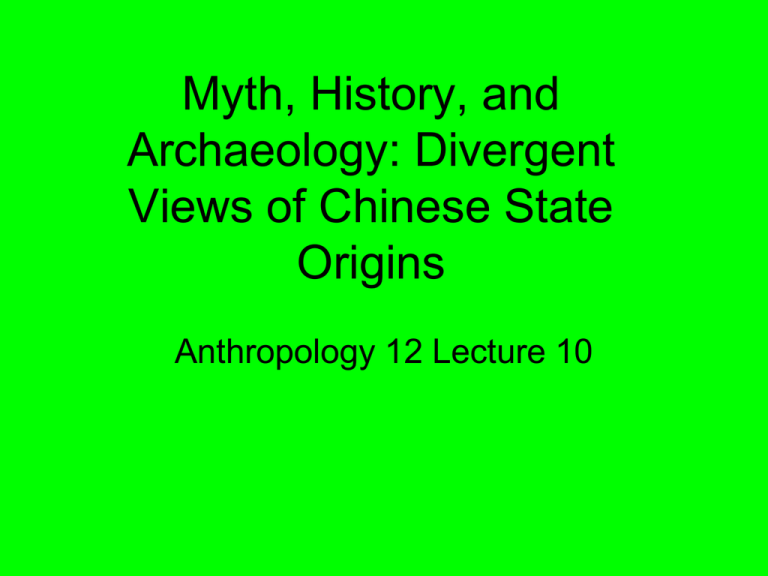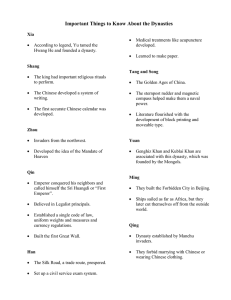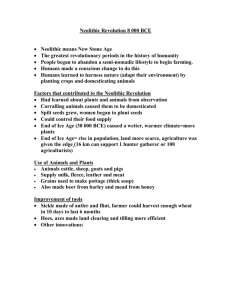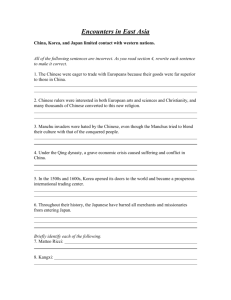Lecture 9 Neolithic China
advertisement

Myth, History, and Archaeology: Divergent Views of Chinese State Origins Anthropology 12 Lecture 10 China’s Significance to World Archaeology • Record of primate evolution reaching back to the Paleocene. • Record of hominin evolution second only to Africa in chronological depth. • Point of origin for ¼ of the world’s languages. • Early transition to agriculture. • Place where some of the earliest statelevel societies appeared. Differences Between Anglo-American and Chinese Perspectives on China’s Past Chinese Anglo-American Tendency to conflate myth and history. Skepticism concerning reliability of Chinese historical sources. Primacy accorded to historical sources Historical and archaeological records accorded equal weight. Orthodox Marxist interpretative framework (Marx/Engels). Varied theoretical perspectives. Empiricism. Nationalism. Belief in ethnic uniformity. Outsider (etic) perspective. Case in Point: The Origins of Statehood in China Traditional Historical Synthesis: from Shiji or Records of the Grand Historian by Sima Qian, composed 109-91 BC Three Sovereigns Five Emperors, beginning with the Yellow Emperor (Huángdì) (27th century BC) Xia Dynasty 2205-1766 BC Shang Dynasty 1765 – 1123 BC Zhou Dynasty 1122 – 256 BC Western scholars suspect that the Three Sovereigns and Five Emperors are euhemerized gods. Putative reign would place Huángdì in the Late Neolithic Huangdi is said to be the ancestor of the Han Chinese Huáng Hé - Yellow River in Jinan looking up river. • Northern China: has a more temperate climate. Millet is the predominant grain. Millet was joined by soybeans, wheat, barley, melons, fruit and hemp. Southern China is more tropical. Rice is the dominant grain. Rice is a swamp plant. It grew wild in southern and central China, and was domesticated c. 12,000 years ago along the middle reaches of the Yangtze. Other plants grown in the south included yams, beans, melons, fruits, and vegetables. The Chinese Neolithic North China A number of Neolithic cultures have been identified spanning the period 8,500 – 7,000 years BP. These cultures possessed a range of domesticated plants and animals and wellmade stone tools and pottery, showing that initial domestication had preceded them. Origins of pottery are now placed at 20,000 years ago. Cishan-Peiligang Culture, Hebei and Henan Provinces 500 rectangular grain storage pits were excavated; each could hold 1,000 kilograms of grain. South China Diaotonghuan Excavated in 1994 by Yan Wenming and Richard “Scotty” MacNeish. Layer D produced phytoliths of domesticated rice, dated to 10,000 – 8,000 years ago. Hemudu Village, Zhejiang Province • Hemudu Culture dates to 7,000-6,500 BP. • Site had exceptionally well-preserved long wooden houses on stilts. The Yangshao Period 5,000-3,000 BCE Banpo Village, Banpo Culture Located in the Wei River valley. The village dates to 4500 BCE. It was excavated from 195557. Equipment related to hunting and fishing outnumbered tools related to agriculture. Pottery Kiln, Banpo Village The fish is a symbol of prosperity in modern China, and is often found on bowls Shaman’s burial. Xishuipo, Henan Goddess Temple and burial mounds –Niuheliang N. China 3500 BCE Niuheliang ritual complex The Longshan Period 3000-2000 BC Pottery attests to the existence of the fast wheel. Táosi, Shanxi Province The settlement’s wall enclosed 3,000,000 sq. m. Elite grave goods 1% of the graves were type A or B elite graves. Wooden drum covered with crocodile skin, Taosi 2600-2000 BCE Town surrounded by rammed earth wall, Wangchengang, Henan Province 2000 BC Set of stone chimes in the forbidden city, Qing Dynasty Sacrificial pit, Wangchengang Ritual Homicide Langzhiu Culture 3300 BC – 2250 BC • Located on the Yangtze River Delta • Had developed into a complex society by 3,000 BC. • Known for a rich assortment of ritual jade objects and silk weaving. bi cong Taotie mask yue








